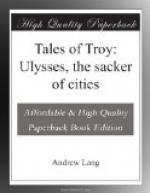HOW PEOPLE LIVED IN THE TIME OF ULYSSES
When Ulysses was a young man he wished to marry a princess of his own rank. Now there were at that time many kings in Greece, and you must be told how they lived. Each king had his own little kingdom, with his chief town, walled with huge walls of enormous stone. Many of these walls are still standing, though the grass has grown over the ruins of most of them, and in later years, men believed that those walls must have been built by giants, the stones are so enormous. Each king had nobles under him, rich men, and all had their palaces, each with its courtyard, and its long hall, where the fire burned in the midst, and the King and Queen sat beside it on high thrones, between the four chief carved pillars that held up the roof. The thrones were made of cedar wood and ivory, inlaid with gold, and there were many other chairs and small tables for guests, and the walls and doors were covered with bronze plates, and gold and silver, and sheets of blue glass. Sometimes they were painted with pictures of bull hunts, and a few of these pictures may still be seen. At night torches were lit, and placed in the hands of golden figures of boys, but all the smoke of fire and torches escaped by a hole in the roof, and made the ceiling black. On the walls hung swords and spears and helmets and shields, which needed to be often cleaned from the stains of the smoke. The minstrel or poet sat beside the King and Queen, and, after supper he struck his harp, and sang stories of old wars. At night the King and Queen slept in their own place, and the women in their own rooms; the princesses had their chambers upstairs, and the young princes had each his room built separate in the courtyard.
There were bath rooms with polished baths, where guests were taken when they arrived dirty from a journey. The guests lay at night on beds in the portico, for the climate was warm. There were plenty of servants, who were usually slaves taken in war, but they were very kindly treated, and were friendly with their masters. No coined money was used; people paid for things in cattle, or in weighed pieces of gold. Rich men had plenty of gold cups, and gold-hilted swords, and bracelets, and brooches. The kings were the leaders in war and judges in peace, and did sacrifices to the Gods, killing cattle and swine and sheep, on which they afterwards dined.
They dressed in a simple way, in a long smock of linen or silk, which fell almost to the feet, but was tucked up into a belt round the waist, and worn longer or shorter, as they happened to choose. Where it needed fastening at the throat, golden brooches were used, beautifully made, with safety pins. This garment was much like the plaid that the Highlanders used to wear, with its belt and brooches. Over it the Greeks wore great cloaks of woollen cloth when the weather was cold, but these they did not use in




